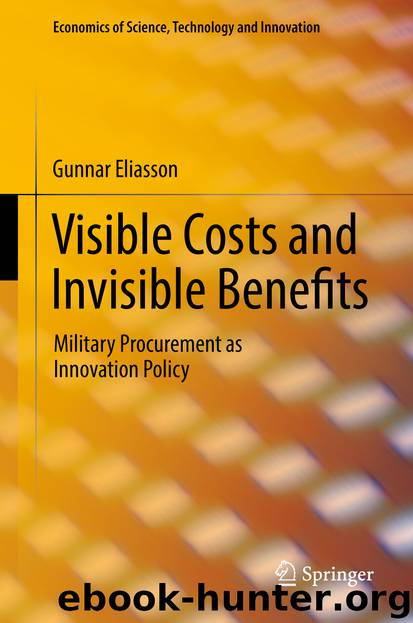Visible Costs and Invisible Benefits by Gunnar Eliasson

Author:Gunnar Eliasson
Language: eng
Format: epub
Publisher: Springer International Publishing, Cham
9.9 The Procurement Choice
Weapons systems, more than other industrial (systems) products, need to be tailored to the special demands of the user. This is particularly so for a nation organized to protect itself from aggressive enemy action, rather than being an aggressor itself. This means large production costs because of a combination of large development investments and short production runs, unless lack of volume cannot be countered by new and flexible production methods or exports, or the spillovers (mostly originating in design and development) cannot be demonstrated to be so large as to make the cost issue irrelevant.
By being capable of cleverly designing and flexibly modifying its weapons system for protection and defense, larger military resources on the enemy side will be tied up than if the aggressive enemy will only have to deal with familiar defense technologies. This in itself makes military aggression a costly enterprise. And to achieve that unique edge in defending ones country, the nation needs to be in sovereign control of its military technology. Hence, indigenous weapons development and manufacturing are to be preferred to buying standardized equipment off-the-shelf, that the enemy is already familiar with, provided the own industrial base is capable of delivering the weapons needed up to (military) customer specifications.
If the indigenous industrial base is lacking, it can be improved upon through international industrial cooperation. Gustavus Wasa of Sweden and his sons understood that already in the sixteenth century (see Chap. 2). They overcame Sweden’s lack of a needed industrial base by first temporarily purchasing used naval equipment off-the-shelf from the Hansa League. But the king also realized that the military support of the strong Hansa League was based on a temporary strategic advantage, that might soon disappear, and engaged in the much longer-term venture of “importing” the human capital needed to build own industrial capacity to manufacture sophisticated weapons, notably from Flandern (Chap. 2 again). This FDI of immigrant human capital from Holland combined innovatively and efficiently with Swedish raw material resources, notably iron ore, to create a competitive, export-oriented weapons making industry already in the seventeenth century. Over three more centuries that industry has gradually evolved into the broad-based and sophisticated engineering industry Sweden now has. Over three centuries Sweden thereby “accidentally” freed its economy of its raw material dependence, to finally become an advanced and wealthy industrial economy during the twentieth century. To begin with it produced its own weapons. With time, and thanks to its competent and professional military customers, Sweden began to enjoy spillovers in the form of increasing net military export values based on the industrial knowledge it had accumulated from its weapons production for its own use. Finally, and in the even longer run, the military industry, and the skilled workforce it had fostered, helped usher in an industrial revolution already in the early nineteenth century in the form of a military production capacity transformed into civilian producers and new civilian business formation (Fig. 1.1a, b), the ultimate spillover. To be noted from the previous
Download
This site does not store any files on its server. We only index and link to content provided by other sites. Please contact the content providers to delete copyright contents if any and email us, we'll remove relevant links or contents immediately.
International Integration of the Brazilian Economy by Elias C. Grivoyannis(85041)
The Radium Girls by Kate Moore(11851)
Turbulence by E. J. Noyes(7888)
Nudge - Improving Decisions about Health, Wealth, and Happiness by Thaler Sunstein(7449)
The Black Swan by Nassim Nicholas Taleb(6935)
Rich Dad Poor Dad by Robert T. Kiyosaki(6306)
Pioneering Portfolio Management by David F. Swensen(6162)
Man-made Catastrophes and Risk Information Concealment by Dmitry Chernov & Didier Sornette(5870)
Zero to One by Peter Thiel(5629)
Secrecy World by Jake Bernstein(4588)
Millionaire: The Philanderer, Gambler, and Duelist Who Invented Modern Finance by Janet Gleeson(4282)
Skin in the Game by Nassim Nicholas Taleb(4118)
The Age of Surveillance Capitalism by Shoshana Zuboff(4108)
The Money Culture by Michael Lewis(4016)
Bullshit Jobs by David Graeber(3982)
Skin in the Game: Hidden Asymmetries in Daily Life by Nassim Nicholas Taleb(3862)
The Dhandho Investor by Mohnish Pabrai(3626)
The Wisdom of Finance by Mihir Desai(3597)
Blockchain Basics by Daniel Drescher(3418)
